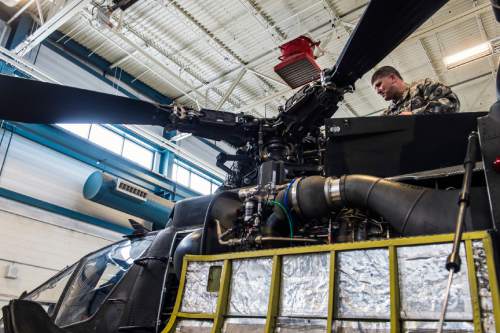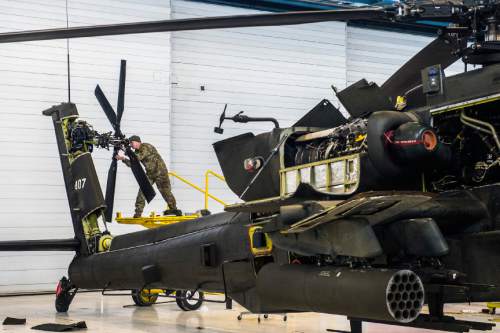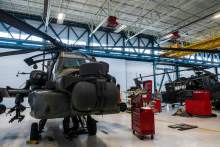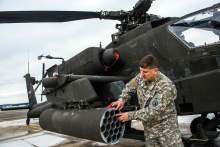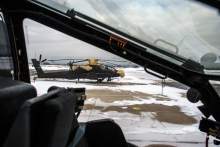This is an archived article that was published on sltrib.com in 2016, and information in the article may be outdated. It is provided only for personal research purposes and may not be reprinted.
West Jordan • Army National Guard Sgt. Andrew Riggs was working on the tail rotors of an AH-64 Apache attack helicopter here Thursday. He paused to ponder what he would do if that aircraft flew away from Utah.
The Army is talking about eliminating some of its Apaches in the National Guard ranks.
Riggs, who is 25, lives in Orem and has been in the Utah National Guard for six years, said maybe he would seek a new job with the National Guard. But it's not clear that job would be full time, like the one he has now.
"We've been kind of nervous with all that," Riggs said.
A report released last month from the National Commission on the Future of the Army calls for reducing the number of Apache battalions in the National Guard ranks to four from eight. Each now has about 20 aircraft; the survivors would have their Apache numbers increased to 24, with the rest of the helicopters going to active-duty units.
The battalions that lose the Apaches could receive some Black Hawk helicopters, mostly used to transport troops and equipment, in return.
It's unclear if the Army will follow the recommendation. It could leave the Apaches — the fast and sleek helicopters that can fire rockets, missiles or bullets at ground targets and provide cover for infantry — dispersed as they are or operating under an alternative.
But, for the moment, Utah's 1st Battalion, 211th Aviation Regiment — nicknamed the Air Pirates — is pitted against Apache battalions in Arizona, Idaho, Missouri, North Carolina, Pennsylvania, South Carolina and Texas.
About 120 soldiers and civilians work full time maintaining Utah's Apaches. Black Hawks don't require as many maintainers, so some of those 120 jobs would disappear, the Utah National Guard has said.
The Utah National Guard believes it has some strong arguments for keeping its 16 Apaches. The first is that the state's topography looks and has atmospheric conditions a lot like where the Army most often operates these days — Afghanistan.
"You look outside," said Lt. Col. Matthew Badell, as he nodded toward a window at the National Guard armory in West Jordan, "you see Afghanistan."
Altitude and atmosphere are important factors in how a helicopter performs. Badell, an Apache pilot who deployed to Afghanistan in 2004 and 2005, said Utah provides better training than a pilot will experience at sea level.
The Utah National Guard also uses the same selling point that supporters of Hill Air Force Base have used every time it has faced a cut from the Pentagon. The Air Pirates fly and target practice in the sky above Dugway Proving Ground, the Utah Test and Training Range and the massive swath of west desert airspace that is reserved for the military.
The Utah National Guard also has produced statistics showing its Apaches are maintained as well and as cheaply as any active-duty unit.
Cost savings are a major reason the Army has been pondering what to do with its Apaches and why the issue was handed to the National Commission on the Future of the Army.
The commission considered a proposal to keep six Apache units in the National Guard ranks, but found that would have added between $90 million and $175 million to the budget proposed by the Obama administration.
Laborers International Union of North America Local 1776, which represents civilian employees working for National Guards across the country, has been fighting the Apache transfers. Local 1776's business manager, Ben Banchs, contends the Army will reduce cost-saving National Guard units in favor of the more-expensive active-duty battalions.
"If the Army's intent is to do the mission at a reduced cost," Banchs said, "then their plan to take the Apaches out of the National Guard is particularly ridiculous."
Banchs expects Utah's arguments about the benefits of its altitude will have limited effectiveness.
"I don't think it will have any weight with the bean counters," he said. "With the war fighters, absolutely."
The commission's plan says any National Guard Apache battalions that survive will have to be deployed more often. Badell said that won't be a problem. The Air Pirates have had multiple deployments through the years, most recently in 2012.
Chief Warrant Officer Ken Jones recently retired from the Utah National Guard as the first Apache pilot to fly more than 10,000 hours.
"We've done it before; got the T-shirts," Badell said. "There's still room in the drawer."
Twitter: @natecarlisle





